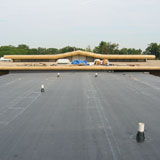The spring day broke clear and mild as Jeff gently turned his truck onto the interstate heading toward a new job site. It was the start of his first week as safety manager for Big Valley Roofing, and his mind was churning as he went through a mental list of items for a large warehouse reroofing project.
Jeff was confident the prejob meetings he attended with Big Valley Roofing's owner, superintendent and foremen had completely addressed some complicated fall-protection issues at the site. As he approached the warehouse entry gate, he saw warning lines already had been established around the roof perimeter and guardrails were set up by the debris-chute opening.
His initial comfort level suffered a severe jolt as he drove closer to the warehouse. Placed a couple of feet off the main drive were three liquid propane gas (LPG) cylinders with "Big Valley Roofing" stenciled on them. And a nearby kettle already was fired up, but no fire extinguisher was in sight.
As Jeff pulled into a parking spot, he noticed the crane Big Valley Roofing had leased was operating with the boom too close to the service drop that supplied power to the warehouse. He immediately warned the crane operator to cease operation and move the crane back—Occupational Safety and Health Administration (OSHA) regulations require a minimum distance of 10 feet (3 m) from any part of a crane or load to an energized power source.
Jeff made his way to the roof to see whether he could find Don, Big Valley Roofing's superintendent. To his dismay, he noticed a reciprocating saw and an extension cord with exposed wires protruding from torn sheathing.
Jeff confronted Don about the hazards. Don explained that the crane leasing company was not part of the prejob planning process and no one had provided a detailed description of how the operator should proceed once on the job. As for the tools, Don said the large job size required more tools and equipment than the crew typically uses. To support the workload, some crew members were forced to take tools from the shop that may have been taken out of service but not discarded or repaired.
Don was aware OSHA regulations require a minimum-rated 10B fire extinguisher to be located within 50 feet (15 m) of an LPG cylinder and that propane must not be in close proximity to vehicular traffic. Don explained that in the crew's haste to set up, the workers had overlooked having a fire extinguisher at the job site and properly storing the kettle's propane cylinders.
Jeff saw the morning's violations as a symptom of a larger problem.
He looked Don squarely in the eye and said: "Don, we're shutting the job down for the day. Get everyone off the roof."
Don was furious and radioed Big Valley Roofing's office to talk to its owner, Ted. Don told Ted what had happened and muttered that "he wasn't going to let some new safety freak shut down his project."
Ted paused as he quickly calculated what each hour of inactivity was costing him. Then, Ted calmly said, "Yeah, Don, wrap it up and have everyone back at the office in one hour."
When everyone was at the office, Ted told the crew job safety is a top-down process and that is why he supported Jeff's decision. He asked Jeff to lay out the issues for discussion with Don and the crew.
Jeff explained that during prejob meetings, everyone was so focused on the complex fall-protection hazards that the balance of the job-specific safety plan was overlooked. He detailed the hazards the project posed and helped lead the discussion of preparations needed for the next day and weeks ahead.
As the warehouse project progressed, Jeff and Don developed written safety checklist procedures to address issues on a variety of job sites. The checklist focused on all safety issues and delegated responsibility for each issue to a specific employee.
A key component of their approach was a consistent method for conveying safety plan elements to company workers and subcontractors. Before the start of each job, Jeff would communicate the job-specific safety procedures each subcontractor was expected to follow. As jobs progressed, Don would ensure the subcontractors complied with the procedures and Big Valley Roofing foremen understood their safety obligations. Each foreman would act as a safety team leader with specific duties relating to proper equipment setup, equipment needs and safe work practices.
At the end of the warehouse project, Jeff and Don agreed the checklist procedures would have helped avoid the safety violations present on the first day of work. Fortunately, no injuries resulted from the initial oversights and everyone was confident the procedures would help make future projects run smoothly and safely.
Harry Dietz is NRCA's director of risk management.


